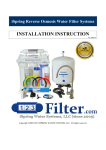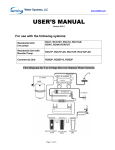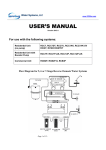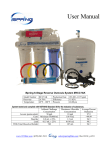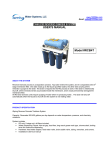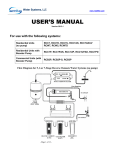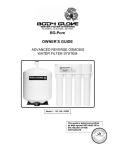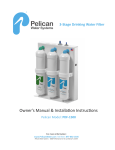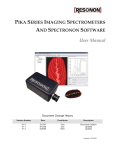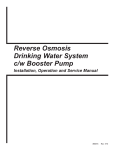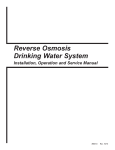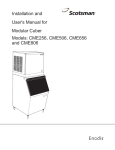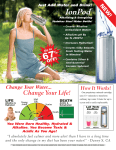Download INSTALLATION INSTRUCTION AND OWNER`S MANUAL Ver 2015-6
Transcript
iSpring Reverse Osmosis Water Filter Systems INSTALLATION INSTRUCTION AND OWNER’S MANUAL Ver 2015-6 Copyright ©2005-2015 ISPRING WATER SYSTEMS, LLC. All rights reserved. Please keep this owner’s manual for future reference. It includes the information on how to properly operate and maintain your iSpring Reverse Osmosis water filtration system. TABLE OF CONTENT BEFORE INSTALLATION ..................................................................................................................... 2 Inspect the package ............................................................................................................................... 2 Recommended tools list ........................................................................................................................ 2 Operating conditions ............................................................................................................................. 2 Components Identification.................................................................................................................... 3 Installation Tips ........................................................................................................................................ 4 How to use Quick-Connect fitting ........................................................................................................ 4 To connect: ....................................................................................................................................... 4 To disconnect: ................................................................................................................................... 4 How to use Compression fitting with brass Nut, Collar, and tube Insert ............................................. 5 How to drill a hole on sink or counter-top ............................................................................................ 5 Installation Steps....................................................................................................................................... 7 Step 1: Install 3/8” Feed Water Adapter (AFW) .................................................................................. 7 Step 2: Install Drinking Water Faucet .................................................................................................. 7 Step 3: Install Drain Saddle .................................................................................................................. 8 Step 4: Install the Vertical Filters: Stages 1, 2, and 3 ........................................................................... 8 Step 5: Install Tank Shut-off Valve (TSV) ........................................................................................... 8 Step 6: Install Reverse Osmosis Membrane ......................................................................................... 9 Step 7: Tubing Hook up (model specific sub-steps are marked with * ) .............................................. 9 Step 8: System Start Up (model specific sub-steps are marked with * ) ............................................ 10 SYSTEM MAINTENANCE .................................................................................................................. 12 Stages 1 – 3 pre-filters: Replace every 6 – 12 months, or sooner if water flow gets slow. ................ 12 How to change in-housing cartridges in 1st – 3rd pre-filter stages .................................................... 12 Stage 4 RO membrane: Replace every 2 – 3 years or sooner if TDS level starts increasing. ............ 13 How to change reverse osmosis membrane ........................................................................................ 13 Stage 5 T33 fine carbon: Replace every 12 months ........................................................................... 13 How to change inline cartridges in 5th – 7th stages ........................................................................... 13 O-rings: Replace every 3 years or sooner if leak happens at O-ring. ................................................. 13 Extra Installation ..................................................................................................................................... 14 UV Lamp (part# iSpring UVB11) and Ice maker kit (part# iSrping ICEK) ...................................... 14 Limited Warranty.................................................................................................................................... 15 Warranty Registration ............................................................................................................................. 23 www.123filter.com | (678) 261-7611 [email protected] Page 1 Thank you for choosing the iSpring Reverse Osmosis Water Filtration System. It was built from quality components, and has earned WQA GOLD SEAL certification against NSF/ANSI STANDARD 58 for performance and material safety. Please check the attached iSpring RO Systems WQA Gold Seal Certification for details. BEFORE INSTALLATION Inspect the package Please open the box, and take all the components and tool kit out. Inspect them to ensure that nothing is damaged during shipping. If any part is cracked or broken, please immediately contact iSpring Customer Support for replacement. Identify and get familiar with the components. Recommended tools list • • • • Variable speed drill with two bits: ¼” (for drilling a hole on PVC drain pipe), ½” hollow diamond (for drilling a hole on countertop for drinking faucet) 5/8”, 9/16” open-end wrench, or adjustable wrench, pliers Phillips screwdriver Scissors or utility knife Operating conditions • • • • • Maximum water pressure: 80 psi, or pressure regulator (part no. APR70) is required if there is high water pressure or water hammer) Minimum water pressure: 40 psi, or booster pump is needed to improve RO efficiency Water temperature: 40 – 100 °F (4 - 37 °C) (This RO system is NOT designed for HOT water) Maximum TDS: 750 ppm Install this RO system in a location where it is safe from hot/cold weather and direct sunlight. Avoid hitting, falling, or dragging as they may cause cracks and leaks. www.123filter.com | (678) 261-7611 [email protected] Page 2 Components Identification RO machine head (membrane not yet installed) 3 Pre-filter housings and cartridges Storage tank Drinking faucet with installation kit Feed Water Adapter (AFW) 4-color tubing set Drain saddle ¼” Tank valve Housing wrenches Teflon tape Spare Housing O-rings x 3, Elbow Fitting x 2, Lock Clips Water Detector (optional) www.123filter.com | (678) 261-7611 [email protected] Page 3 Installation Tips How to use Quick-Connect fitting Figure 1 To connect: 1. See Figure 1. Check and cut the tubing end squarely and cleanly with utility knife or scissors. 2. Make a mark at the end of tubing. The lengh is about ½ inch, the depth of the fitting body. 3. Fully insert the tubing until the mark is about to disappear. This ensures that it is sealed by the O-ring near the bottom. Figure 2 Figure 3 To disconnect: 1. See Figure 2 and 3. Remove the blue Lock Clip. 2. With two fingers PUSHING IN and PRESSING DOWN the Lock Sleeve to eliminate the Gap that the blue Lock Clip occupied, pull the tubing out. (Pressing down the Lock Sleeve releases the spring-loaded steel teeth that grab the tubing inside the fitting body). www.123filter.com | (678) 261-7611 [email protected] Page 4 How to use Compression fitting with brass Nut, Collar, and tube Insert Compression fitting is used to connect the PVC tubing to the threaded metal inlet with a tapered open end, such as the refrigerator water inlet, drinking faucet water inlet, etc. Figure 4 1. 2. 3. 4. Slide the Nut, Collar onto the end of tubing Fully insert the Insert into the open end of tubing Slide the Collar to be close to Insert and fit into the tapered open end of the thread metal inlet. Screw on the Nut and tight it up. The Nut compresses the plastic Collar onto the tapered metal surface and creates a water seal between them while the Insert hardens the tubing. How to drill a hole on sink or counter-top 1. It’s highly recommended to watch the YouTube video “How To Drill Faucet Holes.” 2. Choose a half inch Diamond Core Bit for granite, and a titanium drill bit for steel. Do NOT use a hammer drill on nature stone, glass, and ceramic. 3. An indent should be made with a punch on steel before drilling to help guide the bit. 4. Use caution when drilling on a Porcelain sink, as it could be easily chipped. Set drill speed on slow. Press the bit downward firmly until breaking through the slippery surface. 5. Use coolant to disperse heat. Choose water for granite, and oil for steel. Use the Water Suction Cup to hold coolant inside and prevent the drill bit from slipping. 6. Starting at slowest speed, hold the drill firmly and vertically and prevent the drill bit from slipping on the counter. 7. Once breaking through the smooth surface, swirl the drill a little to apply pressure in a circle evenly. 8. Be patient and deliberate. It can take 20 – 40 minutes to drill through one inch. www.123filter.com | (678) 261-7611 [email protected] Page 5 Sample Installation Figure 5 A. Source water from Feed Water Adapter Æ B. Source water to water inlet next to 1st stage C. Waste water from Flow Restrictor Æ D. Waste water to Drain Saddle E. RO water from Automatic Shut-off Valve Æ F. RO water to Storage Tank G. RO water from 5th stageÆ H. RO water to Drinking Faucet An Ice Maker Kit (part# iSpring ICEK) can be purchased separately to feed RO water to refrigerator and get crystal clear ice cubes and great tasting water at ease. It could make Drinking Water Faucet not absolutely necessary. Figure 6 www.123filter.com | (678) 261-7611 [email protected] Page 6 Installation Steps Before you begin installation, it is highly recommended that you watch the video “iSpring reverse osmosis installation” on YouTube. Note: Steps 1 – 7 are independent, and can be performed in any order. Step 1: Install Feed Water Adapter (AFW) 1.1 See Figure 5. Turn off the Cold Water Line via the Cold Water Supply Valve (CWSV) under the sink. Open the kitchen faucet to release pressure and make sure water has stopped before proceeding to the next step. Get a towel or bucket to catch any water drips. Disconnect Kitchen Faucet Connector (KFC) pipe from CWSV. 1.2 (Refer to AFW user manual). Check O-ring inside AFW female end, and twist it onto CWSV. Tighten it up using wrench or pliers. 1.3 Twist KFC onto the male end of AFW. Turn the handle of AFW to cross (OFF) position. Turn on CWSV slowly, check and fix any leaks. 1.4 Connect the 1/4” RED tubing to AFW. Step 2: Install Drinking Water Faucet 2.1 If your kitchen sink does not have an existing ½” hole, you will have to drill one. (Refer to How to drill a Hole on Sink or Counter-top). Wipe clean and dry the area. (Contact us for larger front plate and washer if the hole is too big to cover). 2.2 Remove blue protection film from the front plate, slip it on the faucet thread, and slip on the black rubber washer. Insert the faucet thread portion into the hole. Optional plumber glue or sealer could be used. 2.3 Under the sink, tighten the back rubber washer, lock washer with nut. 2.4 (Refer to How to use compression fitting). Slip the compression fitting nut and collar on the BLUE tubing, push the insert into the tubing, insert it into the faucet end, and tighten up the nut. Pull the tubing to check if it is secure. Figure 7 www.123filter.com | (678) 261-7611 [email protected] Page 7 Step 3: Install Drain Saddle 3.1 Choose a spot on the drain pipe that is convenient for installing the drain saddle and tubing. Horizontal pipe is recommended to minimize the dripping sound. 3.2 Drill a 1 /4” hole on the drain pipe; paste the black sticky pad around the hole. 3.3 Cut the BLACK tubing end a bit to make a 45 degree angle. Slip the plastic nut and front plate on the tubing. Insert the tubing into the 1 / 4” hole on the drain pipe, install the back plate and tighten two screws with hex nuts while the tubing remains in the hole. 3.4 Tighten the nut on the Drain Saddle by hand. Pull the tubing to check if it is secure. Step 4: Install the Vertical Filters: Stages 1, 2, and 3 4.1 Make sure that the O-ring is seated inside the groove on top of the filter housing. (Figure 10). Food-grade silicon jelly may be used to help the O-ring stay in place and seal better. 4.2 Filter cartridges are preserved in shrink wrap. Note the direction sign on the sticker before removing the wrap (GAC stage). 4.3 When placing the filter cartridge into its housing, make Figure 12 sure it is centered and the knob protruding from the bottom of the housing fits in the central hole of the filter. 4.4 Screw the housing, with filters attached, onto the housing caps (caps are pre-assembled on the machine head). The cap also has a center knob which should be inserted into the center hole of the filter cartridge. Twist the housing on in a clockwise direction by hand, and then use a housing wrench to tighten it up for about 1/4 – 1/2 turn. Do not over tighten. This can cause leaks and make it difficult to unscrew the housing when replacing filters. 4.5 Follow the steps 1.1 – 1.4 to install the GAC and CTO filters. *Note* the second stage GAC is the only filter that must go in a certain direction. Make sure that the end with the rubber washer faces up, thereby attaching to the housing cap. Step 5: Install Tank Shut-off Valve (TSV) 5.1 Wrap 10 - 15 turns of Teflon tape clockwise (looking from top) onto the metal thread at the top of the tank. 5.2 Screw (clockwise) the Tank Shut-off Valve on and tighten up by hand. Do not over tighten. 5.3 Connect the YELLOW tubing onto the Quick-Fitting of TSV. www.123filter.com | (678) 261-7611 [email protected] Page 8 Step 6: Install Reverse Osmosis Membrane Figure 8 Figure 9 6.1 Open the membrane housing screw cap. First, you will need to disconnect the white 1 / 4” tubing from the Inlet quick-fitting on the membrane housing cap (refer to How to Use Quick-Fitting section), and then unscrew (counter-clockwise) the cap. A thick rubber band can be slipped on the housing body for a stronger hand hold. 6.2 Remove the membrane from its sealed bag. Follow the flow direction sign on the membrane, and firmly insert the membrane into the housing with the smaller end that has two black O-rings heads first until the bigger end is even with the housing opening. See Figure 8-9. 6.3 Before twisting the housing cap back on, check that the O-ring is evenly snagged on the membrane housing (cap does NOT have O-ring). Hang tight and tighten up for about 1 /4 – 1 /2 turns using a small plastic housing wrench, but do not over tighten. DO NOT reconnect the tubing to inlet on cap at this point (will do it in system start up). Step 7: Tubing Hook up (model specific sub-steps are marked with * ) 7.1 See Figure 5 and Figure 10 RCC7P & RCC7 TOP VIEW, note connection points A-B, C-D, E-F, and G-H. www.123filter.com | (678) 261-7611 [email protected] Page 9 Figure 10 7.2 Facing the iSpring logo up front, the pre-filter 1st stage is located on the right hand side. Connect the RED tubing Feed Water Adapter (AFW) (point A) to the elbow fitting (point B). 7.3 Connect the Flow Restrictor (point C) , which is a 3-inch long cylinder with a FLOW sign laying beside the membrane housing, to the Drain Saddle (point D) with the BLACK tubing. 7.4 On the right side of the Post Carbon Filter (FT15 5th stage), connect the Tee-fitting (point E) and the Tank Valve (point F) with the YELLOW tubing. 7.5 * Model without UV/AK/DI: at left end of FT15, insert the BLUE tubing (links to RO faucet) into the elbow fitting. * Model with UV/AK/DI: RO water flows out of point G at FT15 and flows into the left end of next stage. So the BLUE tubing (links to RO faucet) should be connected at the final end of the last stage, which could be the UV/AK/DI filter. 7.6 Connect the other end of the BLUE tubing to the RO faucet (refer to How to use compression fitting). 7.7 You may organize the tubings, but make sure to leave enough length so the filter system can be moved freely in and out of the cabinet when replacing filters. 7.8 You may hang the system using two 10 x 1-1/4 Phillips Flat Wood Screws. This will make replacing filter cartridges easier. Step 8: System Start Up (model specific sub-steps are marked with * ) * If your model has a UV stage, do not plug in power until the system is fully flushed 8.1 Make sure that all tubings are not kinked. Turn Tank Shut-off Valve OFF (cross). Prepare a bath towel to catch any water leak. 8.2 To avoid the residual carbon in the first three stages from getting into the RO membrane, the tubing to the inlet of the RO membrane housing cap was left disconnected. Flush the first three stages into a bucket until the water turns clear, and re-connect the tubing to the RO membrane. (You may do this whenever you change the first three stages). 8.3 Turn on (inline) Feed Water Adapter valve (AFW), and then slowly turn on the Cold Water Supply Valve (CWSV) and check for leaks. The top 3 causes of leaks are 1) The tubing was not fully inserted into the quick-connect fitting. 2) The O-ring was not in place or kinked. 3) The Housing/Cap was not tightened up or off threads. 8.4 * Plug in booster pump power if the model your purchase has one. 8.5 Within 5 minutes, RO water should start dripping. Let it run for at least 10 minutes. This flushes the system except the tank. Water is black due to loose carbon from new carbon filters (step 8.2 could be taken to expedite the flush). It will turn clear with some air bubble. www.123filter.com | (678) 261-7611 [email protected] Page 10 8.6 Shut off the RO Drinking Faucet. Turn on the Tank Shut-off Valve. Wait for the tank to be filled up. It may take 1.5 hours in warm summer or 3 hours in cold winter to fill up a 3.2 gallon tank with about 2.5 gallons holding capacity. 8.7 After two hours, turn on the RO Drinking Faucet to flush out all the water in the tank. DO NOT use the first tank of water. The water out of the faucet should be a much stronger stream since the water pressure was built up to 35-40 psi when being filled up. When the water flow changes back to a trickle, it means the tank is empty. 8.8 * Plug in the UV power and observe if the RO faucet turns the UV on/off through the Flow Sensor Switch. 8.9 The reverse osmosis membrane is the key part for the effective reduction of total dissolved solids (TDS) and that product water shall be tested periodically to verify that the system is performing properly. If the TDS of the source water is 100ppm, the RO water should be less than 10ppm (Rejection rate >90%). 8.10 Check for leaks daily for the first two weeks after installation. Furthermore, a bucket can be put under the system in case of any leaks, and a Flood Alarm can be used together for better protection. Congratulations! You have successfully installed the iSpring Reverse Osmosis Water Filtration System! Start enjoying the cleanest water right from your tap! www.123filter.com | (678) 261-7611 [email protected] Page 11 SYSTEM MAINTENANCE This RO system is designed with ease of use and low maintenance in mind. If you change the filter cartridges as suggested below, and check TDS level periodically, the system will work properly for many years. Note: stage 6 or 7 only exists in certain models. For a filter pack supply, visit 123Filter.com or Google “Model replacement filter” online, in which “Model” is the model number of the system, e.g. RCC7 Stages 1 – 3 pre-filters: Replace every 6 – 12 months, or sooner if water flow gets slow. The frequency depends on the source water quality and water usage. They could last longer in city water, and shorter in well water. Different areas have good or bad water. Some customers reported they had to replace the 1st stage every 1-3 months when they saw through the clear housing where heavy sediments and particles turned the white cartridge into dark brown. Some customers reported they could replace them every 12 months. To protect the RO membrane in the 4th stage, it is required to replace the pre-filters at least every 12 months. How to change in-housing cartridges in 1st – 3rd pre-filter stages 1. Shut off the water supply valve and tank valve, open the faucet to depressurize. Place a bucket or towel under the unit to catch water spills. 2. If there is enough room under the sink and filter system is hung on wall, it could be easier to twist the filter housing off without taking the unit off the wall. Otherwise, it could be easier to pull the system out, lay it down and work towards the housing bottom. Please be careful with tubing connections when pulling the system out. 3. Twist off the filter housing in a counter-clockwise direction when looking from the bottom. Use a housing wrench (the bigger one) if necessary. 4. Refer to Installation Step 1.1 to install a new vertical filter cartridges and twist the housings back on. Remember not to over tighten or it will be hard to open next time. www.123filter.com | (678) 261-7611 [email protected] Page 12 Stage 4 RO membrane: Replace every 2 – 3 years or sooner if TDS level starts increasing. Check the TDS level at least once a month to monitor the system performance. The rejection rate should be above 90% (NSF/ASIN STANDARD 58 for RO water filter). How to change reverse osmosis membrane Figure 11 Figure 12 1. Reverse osmosis membrane usually last about 2 – 3 years, depending on the source water quality and the replacement schedule of the three pre-filters. 2. To ensure system performance and water purity, filter cartridges must be replaced on schedule. Use the TDS meter periodically to check water purity 3. Shut off the water supply valve and tank valve, open the faucet to depressurize 4. Place a bucket or towel under the unit to catch water spills. 5. Remove the tubing from the inlet fitting on the membrane housing cap. Use a housing wrench or by hand to twist off the housing cap in a counter-clockwise direction looking from inlet. 6. Pull out the old membrane. Use scissors or pliers to apply leverage if necessary. 7. Clean the housing using hot water and optional scent-free dish soap. Rinse thoroughly. Cut open the small end of the sealed bag of a new RO membrane, hold the new membrane with the bag, and insert it into housing without touching the membane with your bare hand, which may contaminate it. 8. Check the O-ring on the open end of the membrane housing. It is recommended to replace it every 3 years to prevent leaks. 9. Twist the membrane housing cap back on by hand. Use a wrench for a final ¼ turn if necessary. DO NOT over tighten. Stage 5 T33 fine carbon: Replace every 12 months Unscrew the elbow fittings on both ends, put them on the new cartridge, and use new Teflon if necessary. How to change inline cartridges in 5th – 7th stages 1. Please note that the 5th - 7th stages (model specific) have directions and each end may have a different kind of fitting. 2. Disconnect the tubing from the Quick-Connect fitting, unscrew the fitting, unwrap a new cartridge, replace the Teflon tape on the fitting threads if necessary, follow the Æ sign on the label to screw the correct fitting on each end, and reconnect the tubing. O-rings: Replace every 3 years or sooner if leak happens at O-ring. The package comes with 3 spare O-rings for the pre-filter housing, and 1 spare O-ring for the membrane housing. Please save them with this manual. www.123filter.com | (678) 261-7611 [email protected] Page 13 Extra Installation UV Lamp (part# iSpring UVB11) and Ice maker kit (part# iSrping ICEK) Figure 13 Flow Sensor Switch for UV lamp The models with a UV stage have a “U” letter in model number, such as RCC7U, RCCAK-UV, RCC1UP-AK. The UV module comes pre-installed on the models with UV. It should function out of the box. The photos above are for a better understanding about how the components are assembled and work together. The Ice Maker Kit (model#: iSpring ICEK) can be purchased separately to feed RO water to a refrigerator and get crystal clear ice cubes and great tasting water. It would make a Drinking Water Faucet not absolutely necessary. www.123filter.com | (678) 261-7611 [email protected] Page 14 OWNER’S MANUAL Please read this manual for useful reverse osmosis system and maintenance information. TABLE OF CONTENT Section 1: Knowledge Base ................................................................................................................ 16 What Is Reverse Osmosis? ............................................................................................................. 16 How Effective Is Reverse Osmosis Filtration? ............................................................................... 16 What are the specific contaminants that a reverse osmosis system removes? ............................... 16 Does Reverse Osmosis remove pharmaceuticals from water? ....................................................... 17 I have heard that reverse osmosis wastes a lot of water! ................................................................ 17 What is Alkaline Filter? .................................................................................................................. 17 What is DI filter? ............................................................................................................................ 18 What is UV filter? ........................................................................................................................... 18 What is a TDS meter? ..................................................................................................................... 18 Maximum distance from tank to faucet .......................................................................................... 18 Section 2: Troubleshooting Guide ...................................................................................................... 19 Leaking around filter housing (O-ring too small or not in place)................................................... 19 Continuous drain ............................................................................................................................. 19 High TDS level in RO water .......................................................................................................... 19 Tastes and Odors in Product Water ................................................................................................ 20 Faucet Leaks or Drips ..................................................................................................................... 20 What is an ASOV and what does it do? ......................................................................................... 20 Cloudy ice cubes or milky colored water ....................................................................................... 20 UV lamp compatibility ................................................................................................................... 20 Sudden drop in RO water production: There are a few potential factors causing the problem? .... 21 Will the water out of UV filter be hot? ........................................................................................... 21 How do you compare your tankless RO system RCS5T to GE Merlin 700GPD system? ............. 21 www.123filter.com | (678) 261-7611 [email protected] Page 15 Section 1: Knowledge Base What Is Reverse Osmosis? Reverse osmosis, also known as hyper filtration, is a membrane filtration process that separates undesirable materials from water by using pressure to force the water molecules through a semipermeable membrane. This process is called "reverse" osmosis because the pressure forces the water to flow in the reverse direction (from the concentrated solution to the dilute solution) to the flow direction (from the dilute to the concentrated) in the process of natural osmosis. Reverse osmosis is used to purify water and remove salts and other impurities in order to improve the color, taste, odor and/or properties of your water. R/O filtration can remove up to 99% of most contaminants including arsenic, nitrates, radium, chromium, fluoride, and dissolved solids such as sodium, calcium, iron, magnesium, copper, etc. How Effective Is Reverse Osmosis Filtration? Reverse osmosis filtration is by far the most effective and economic method of water filtration. It filters water by squeezing water through a semi-permeable membrane, which is rated at 0.0001 micron (equal to 0.00000004 inch). This is the same technology used to make bottled drinking water. It is also the most used technology for desalinating seawater, making it into drinking water. What are the specific contaminants that a reverse osmosis system removes? iSpring Reverse Osmosis filtration systems reject a wide variety of impurities. Here is a partial list: Item Rejection Rate Item Rejection Rate Aluminum 97-98% Manganese 96-98% Amoebic Cysts 99% Mercury 96-98% Ammonium 85-95% Nickel 97-99% Arsenic 94-96% Nitrate 93-96% Asbestos 99% PCBs 97% Bacteria 99+% Pesticides 90+% Barium 90-98% Phosphate 99+% Bicarbonate 95-96% Polyphosphate 98-99% Boron 50-70% Potassium 92-97% Bromide 93-96% Proteins 90+% Cadmium 96-98% Protozoa 99% Calcium 96-98% Pyrogen 99+% Chloride 94-95% Radioactivity 95-98% Chromate 90-98% Radium 97% Chromium 96-98% Sediment 99% Copper 97-99% Selenium 97% Cryptosporidium 99% Silica 85-90% Cyanide Silicate 95-97% 90-95% www.123filter.com | (678) 261-7611 [email protected] Page 16 Detergents 97% Silver 95-97% Ferro cyanide 98-99% Sodium 92-98% Fluoride 94-96% Strontium 90-95% Giardia 99% Sulfur/Sulfate 97-98% Hardness 93-97% Sulphite 96-98% Herbicides 97% TDS 95-99% Hydrocarbons 90+% THMs 90+% Insecticides 97% Trichlorethylene 90+% Iron 98-99% Virus 99+% Lead 96-98% Zinc 98-99% Magnesium 96-98% Note: You may or may not have these contaminants in your water. The percentage rejection rate is for reference only. Percentages may vary since water chemistry varies in each water supply. Does Reverse Osmosis remove pharmaceuticals from water? Yes, the 5-stage RO with carbon pre filters can remove most of pharmaceuticals from water. An activated carbon filter gives these contaminants a charge so they are absorbed and removed. Will a reverse osmosis water system taste as good as the water I pay $5.00 a bottle for? Yes! Sometimes better, depending how well the bottled water company is maintaining their purification equipment. Reverse Osmosis is the same process used by most major bottled water companies. Even some companies that use "spring water" still use Reverse Osmosis to insure purity. I have heard that reverse osmosis wastes a lot of water! It wastes a little but not a lot. On the average, these systems will use less than 2% of your home's total water consumption. In addition, all Our Reverse Osmosis Systems use automatic shut off valves. The drain will stop when the tank is full. The ratio of drain water to RO water is 2:1 for all of our RO systems. For a regular residential household, the waste water per day is about 3 more flushes of toilet, which is not too bad. What is Alkaline Filter? The Alkaline filter changes the acidic RO water into a perfect Natural Alkali Calcium Ionized Water. The Alkaline filter simply gives back minerals such as ionized calcium, magnesium, sodium, potassium ion, which were taken away while purifying the water. • • • • • Produces perfectly ph-balanced alkaline water, helps minimize the fluctuations of your body's pH Turn acidic drinking water into alkali calcium ion water. This natural calcium, magnesium, sodium, potassium ions can be absorbed 100% by the body. It is easily absorbed in the body because it has structurally smaller molecules which help the body take in more water and replenish quickly lost water. Makes the water cleaner and healthier. www.123filter.com | (678) 261-7611 [email protected] Page 17 • • This filter improves the qualities of clean water by adding necessary for proper human development and health minerals, such as Calcium, Magnesium, Sodium, Potassium and others readily found in many natural mineral waters. Mainly installed with RO systems to complement their absolute filtration qualities What is DI filter? DI stands for deionization. De-mineralize filter takes the full size RO to a higher level of filtration. It is an excellent inline filter, especially those who live in areas with exceptionally high levels of TOTAL DISSOLVED SOLIDS (TDS) in their tap water. The post deionizer takes the small percentage of contaminants that the membrane could not remove and filters this to greater than 99.99% pure. It will give you close to 0 ppm TDS, Conductivity attainable less than 0.1uS/cm or resistively of close to 18 meg.ohm What is UV filter? Our UV filter comes with 11W UV sterilization lamp in a stainless still housing. UV kills 99% of virus and bacteria. The UV light of wavelengths between 250 and 270 nanometers (UV-C or UVC band) is extremely effective in killing many species of bacteria, mold spores, viruses and other microorganisms. UV filter is recommended for customers who uses well water, rain water, or has bacteria concern on their water. What is a TDS meter? A TDS meter is a Handheld Total Dissolved Solids Tester. Total Dissolved Solids are the total weight of all solids that are dissolved in a given volume of water, expressed in units of mg per unit volume of water (mg/L), also referred to as parts per million (PPM). With a TDS meter, you can easily compare the quality of RO water with your original source water. Maximum distance from tank to faucet A maximum distance from tank to faucet of 15 feet is possible. The system will produce a faster flow at the faucet with the shortest tubing run from tank to faucet. www.123filter.com | (678) 261-7611 [email protected] Page 18 Section 2: Troubleshooting Guide Leaking around filter housing (O-ring too small or not in place) First of all, please check if all filter cartridges are sitting upright inside the canister. Then, check if Oring is properly in place. The o-rings may be a little too small, please stretch it out and put it back inside the groove. You may over-stretch a little so when it is back to the canister, it will shrink and fit just right. Then insert the cartridge to the top cap, screw the canister all the way up. MAKE SURE ORINGS are staying in place during this process. Then use a wrench to tighten (no need to over tighten it). Little water out of faucet, tank is heavy and appears full of water, but the stream turns very weak after a few seconds If there is no change in the supply water pressure, the problem is very likely from the tank. It could be due to low tank pressure or broken bladder. Perform the following steps first? • • • • • Shut off main water supply Get a bucket under the tank and remove tank by disconnecting the ball valve. Dump the water from the tank by turning it upside down (through the top stem). You may add air from the front valve to help emptying the water. Use a gauge at the front air valve to check tank pressure. It should be within 7-10 PSI. If too low, you can use a bicycle pump to add more pressure to the tank. Re-connect tank to the system and turn on the water supply. Continuous drain All RO systems create drain water. The drain water should run only when the system is making water. The ratio of drain water to RO water is about 0.8-3:1 for our RO systems (Pumped, Side-Flow systems have lower ratio). For a regular residential household, the waste water per day is about 3 more flushes of toilet, which is not too bad. The drain should stop after the tank is full. Allow 3 hours for the tank to fill up. If the drain is still running, the problem might be caused by the following reasons? • • • • Faulty automatic shut-off valve (ASV, the white square valve that connects to 4 tubings), Faulty check valve (at the pure water outlet of the membrane housing), Faulty flow restrictor (the small tube that marks "flow 300" and connects to the drain line). Low tank pressure. High TDS level in RO water The RO system should produce a TDS rejection rate of about 85-95%. Check the following first? • • • What is tap water TDS reading? Is there a sudden increase in tap water TDS level. Has the RO membrane been installed? It is packed in a vacuum plastic bag and in blue color, located in the accessory box. Possibility of reverse drain line and pure water line. Compare your tubing connection to the diagram on the manual and check. www.123filter.com | (678) 261-7611 [email protected] Page 19 Tastes and Odors in Product Water Possible Cause Solution Carbon Post Filter is exhausted. Replace Filter. There is foreign matter in Holding Tank. Clean, flush and sanitize the Holding Tank. Replace filters. Product water and Drain water lines are reversed. Correct plumbing. Dissolved gases in feed water. Pre-treat feed water to remove gasses. Increase in Product Water TDS. See High TDS in Product Water Section Faucet Leaks or Drips Possible Cause Solution Water leaks from faucet spout. Adjust faucet by turning the tee bar located under the handle to provide a small amount of free play in the handle when shut off. Should this not work, repair or replace the faucet. If leaks from beneath the handle, repair or replace the faucet. What is an ASOV and what does it do? ASOV is automatic shut-off valve. This valve allows your system to turn off the water supply, using pressure from the pure water side of the system. It will turn off the water supply to the unit, whenever there is sufficient pressure on the pure water side of your system. ASOV is a must. It saves water, extends filter life, and improves the performance of your unit. As the storage tank fills the pressure inside increases, when the pressure equals ½ to 2/3 your feed water pressure, the water to the system is shut off. No waste. Since you subtract the storage pressure from the operating pressure, the storage pressure needs be limited. Cloudy ice cubes or milky colored water Bad membrane - Use TDS Meter to check membrane. Replace membrane and sanitize when below 75% rejection. Water supply High oxygen content or air bubbles – If filter cartridges are still new, it is normal and should clear up in two weeks. UV lamp compatibility We have upgraded the UV lamp to a higher-quality brand (Philips) with 2 pins at each end since last November 2011. If your system was purchased before Nov. 2011, a new UV transformer and a UV wire are required. The transformer is available for sale at 123filter.com, under model # UVT11. However, for old customers, we will offer $15 discount for the new transformer, and no charge on the wire. Please go to 123filter.com and type in UVB11 and UVT11, then remark about the $15 discount and the free wire. After installation, the water out of the RO faucet is only a trickle. Is this normal? Reverse osmosis is a very slow process. Water flow is only continual drop if bypassing the tank. With the pre-pressured tank, the water out of the faucet will be about 7-10PSI (tank's pressure), which is pretty strong flow. It takes about 2-3 hours to get the tank filled up, then the system will shut off automatically and drain stops running. www.123filter.com | (678) 261-7611 [email protected] Page 20 Sudden drop in RO water production: There are a few potential factors causing the problem? • • • • • • • • • • Feed water valve is plugged or closed. Sediment/Carbon prefilter or Carbon Post Filter is clogged. Low incoming water pressure. Reverse Osmosis Membrane is fouled. Air pressure in holding tank is incorrect. Air Bladder in Holding Tank is ruptured. Holding Tank valve is closed. No water to drain. Drain Flow Restrictor is clogged. Check Valve on RO Membrane Housing is stuck. The Automatic Shut-Off Valve is Malfunctioning. Will the water out of UV filter be hot? Traditionally, the water coming out of the UV filter is a bit hot, up to 117F, for the first few seconds. However, iSpring UV filter features Smart Flow Sensor valve that automatically turns on and off UV by water flow, simultaneously controlled by drinking faucet. The UV stays off until drinking faucet is turn on. So no more hot water out of UV filter. How do you compare your tankless RO system RCS5T to GE Merlin 700GPD system? Our RO system is a complete 5-stage filtration system, with 3 pre filters (Sediment, GAC, and CTO), Side-Flow® membranes, and post filter; while the GE Merlin 700GPD has only one prefilter (either sediment or carbon), two membranes, and 1 post filter. Therefore, the GE Merlin is for use in light commercial applications where a separate pre-filter system or backwashing carbon filter system will be utilized. Also, our tankless RO system utilizes patented Side-Flow technology, which waste ratio is less than 1, as compared to the 3:1 in other systems, saves up to 2/3 of water. www.123filter.com | (678) 261-7611 [email protected] Page 21 Warranty This Limited Warranty extends to the original purchaser of the system only. This warranty covers all Manufacturer-supplied items only that prove to be defective in material, workmanship, or factory preparation. This warranty covers parts only; all labor is excluded from this warranty, including, but not limited to, services related to the removal, replacement, installation, adjustment, maintenance, and/or repair of the unit or its components items. excludes all non-Manufacturer labor required for any servicing of the unit, including, but not limited to, servicing related to installation, adjustment, maintenance, and repair of the unit. This warranty applies only for the first full calendar year from date of purchase. The following items are excluded from this warranty: membranes, filters, O-rings, and all other parts or components that require regular replacement as a result of ordinary usage. Disclaimers: This Limited Warranty applies only if the system is installed, used, and maintained in compliance with all instructions and requirements enclosed with the system. This warranty will be void for failure to observe the following conditions: 1. The system is to be used with potable water supply only. 2. Feed water pressure to the unit is no less than 45 PSI (30 PSI for systems with built-in booster pump) and no greater than 80 PSI. 3. The system is to be used on water supplies with chlorine concentrations of 1.0 mg/L (ppm) or less. 4. Feed water temperature to the unit must be no less than 40°F and no more than 100°F. 5. Total dissolved solids (TDS) in feed water must be less than 750 mg/L (ppm). 6. Feed water must have a pH between 4 and 8. 7. Turbidity must be less than 1.0 NTU. 8. SDI must be less than 5. 9. Feed water must be completely free of iron, manganese or hydrogen sulfide. Do not use with water that is microbiologically unsafe or of unknown quality without adequate disinfection before or after the system. While the testing was performed under standard laboratory conditions, actual performance may vary. The Manufacturer does not know the characteristics of your water supply. The quality of water supplies may vary seasonably or over a period of time. Your water usage may vary as well. Water characteristics can also change if the drinking water appliance is moved to a new location. The Manufacturer assumes no liability for the determination of the proper equipment necessary to meet your requirements, and we do not authorize others to assume such obligation on our behalf. This Limited Warranty does not cover any Manufacturer-supplied items that are defective as a result of the use of improper parts, equipment or materials. This warranty does not cover alterations or modifications of the unit or failure of a unit caused by such alterations and modifications. This Limited Warranty does not cover malfunctions of the unit due to tampering, misuse, alteration, lack of regular maintenance, misapplication, fouling due to hydrogen sulfide, manganese or iron, scaling from excessive hardness, turbidity greater than 1.0 NTU, Silt Density Index (SDI) greater than 5.0 SDI, or excessive membrane hydrolysis due to chlorine levels in excess of 1.0 mg/L (ppm). In addition, damage to the unit due to fire, accident, negligence, act of God, or events beyond the control of the Manufacturer are not covered by this warranty. Incidental and Consequential Damages Limitation: The Manufacturer will not be responsible for any incidental or consequential damages as a result of the failure of this unit to comply with express or implied warranties or any defect in the unit, including but not limited to, lost time, inconvenience, damage to personal property, loss of revenue, commercial losses, postage, travel, telephone expenditures, or other losses of this nature. In case some states do not allow the exclusion or limitation of incidental or consequential damages, you may choose to return the system. If you choose to keep it, you insist this exclusion STILL apply to you. Owner’s Warranty Responsibilities: As a condition of this Limited Warranty, the owner must ensure that periodic maintenance of the system is performed as described in the literature enclosed with the system. Neglect, improper maintenance, abuse, modification, or alteration of the unit will invalidate this Warranty. Should your unit develop a defect or otherwise fail to perform in accordance with this warranty, you should contact the retailer from whom the product was originally purchased. Implied Warranties: The implied at-law warranties of merchantability and fitness for a particular purpose shall terminate on the date one year after the date of purchase. www.123filter.com | (678) 261-7611 [email protected] Page 22 Note: in case some states do not allow limitations on how long an implied warranty lasts, you may choose to return the system. If you choose to keep it, you agree that the above limitations STILL apply to you. Warranty Registration We provide a 30-day money back guarantee, 1 year Manufacture Warranty and lifetime tech support to all products. However, we do not have the order information from the vendors other than 123Filter.com. The easiest way to activate the warranty is to forward your order confirmation email to [email protected], along with your comment; or if you prefer, please fill out and mail the form below. Please remember, we love to help customers. If you have any question or concern about our products, please don’t hesitate to call or email us. We will do all that we can to make your purchase a 5-star experience. If you are happy with our product and service, please show your support by writing a product review on Amazon, even with a single line. It takes you just a minute, but means a lot to us. Thank you! iSpring Warranty Registration Form Your Name: Your EMail: Your Phone: Order#: Model#: Order Date: Reviewer ID: Notes: How to reach us Local / International: 678-261-7611 Fax: 678-530-1070 Office Hours: Monday-Friday 9:00 a.m. - 5 p.m. EST Technical Support Hours: Monday-Friday 9:00 a.m. - 5:00 p.m. EST Mailing Address: iSpring Water Systems 3020 Trotters Pkwy, Alpharetta, GA 30004 USA www.123filter.com | (678) 261-7611 [email protected] Page 23 3020 Trotters Parkway Alpharetta, GA 30004 For questions or comments please visit us at: 123Filter.com For technical support, please contact us at: [email protected] 678-261-7611 www.123filter.com | (678) 261-7611 [email protected] Page 24



























